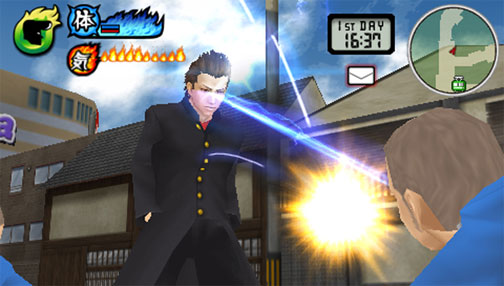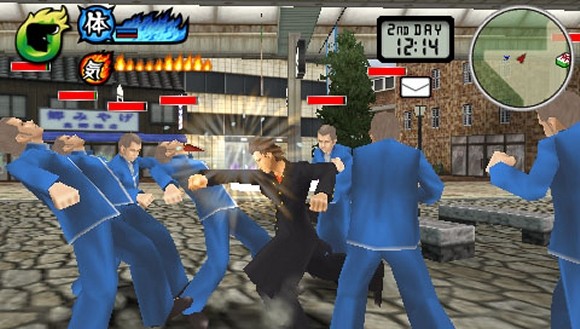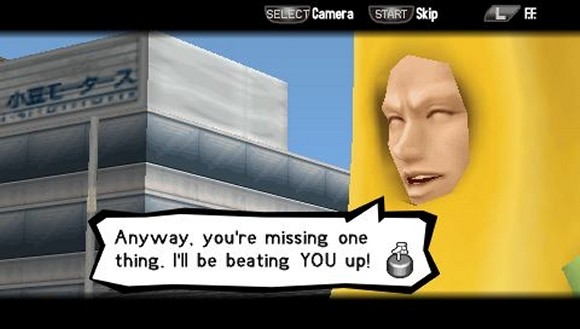A lot of games take themselves too seriously. Whether it’s a dark, metaphoric yarn or a brooding and emotional protaganist, some games just don’t go for a flat out wacky story or tongue-in-cheek tone, trends that are sorely missing from games today.
So it’s always nice to play a game like Kenka Bancho: Badass Rumble. The game never takes itself seriously, has a ridiculous premise, and features some of the most hilarious situations and dialogue I’ve come across in gaming thus far.
In a ludicrous plot that seems like a long-lost treatment of the Bad Dudes story, Kenka Bancho starts off with your character heading off on your school’s customary week-long trip to Kyoto. Your friends on the bus inform you that every other school in Japan is going to be there as well, so you decide that the only option for how to spend your week is to find and beat the 48 other banchos that are going to be roaming around the city. See, a bancho is Japanese for “badass,” or a school gangster. Not quite Yakuza, but not someone to mess with either. With that in mind, it’s time to plan your week, manage your time, level up, and track down the other banchos to become the number 1 bancho in all of Japan.

If that got your blood boiling or made you laugh, then you are already in on this game’s joke. Kenka Bancho takes the best parts of old 80s beat-em-ups, mashes them together with modern free-roaming gameplay ideas, and then pounds them into submission with Japanese culture and memes. It’s like if River City Ransom grabbed GTA by the collar and punched it a few times. I fully embraced this hilarious and insane world, creating a character named Grizzles from FistPunch High, and dived headfirst into Kenka Bancho.
You only have seven days to find and defeat each bancho, and the game’s structure presents the open world of Kyoto for you to explore and requires you to manage your time to complete this task. Kyoto is split up into different main areas that feature one or two smaller side areas. You can travel between these main areas by bus, subway, or taxi, with each method of travel taking up a certain amount of time. You also have school events that you can choose to embark on to gain memories that fill your journal and contribute to your completion percentage, but they take valuable time away from your ass-kicking duties. It’s a constant juggling act with what to do and where to spend your time, and it can get a bit hectic, but the game smartly provides you options to help out.
Every school carries an itenerary that will show you where its bancho will be during the week. You can earn these valuable items by tracking down the respective school members and beating them up. They then have a chance to drop the itenerary, revealing where their bancho will be. Another opportunity is to find the bancho “commander.” Each bancho is the peon of one of these commanders, who are highlighted on your map by a green circle. Defeat them and you beat every bancho under them. Of course, these commanders are quite tough and very hard to find, but if you do, it means big rewards.

Of course, a game that revolves around this much banchosity lives and dies on its combat system, and this is where Kenka Bancho stutters. Combat is excruciatingly slow. Punches and kicks are thrown as if your body was covered in molasses and you were also glued to the ground. Your enemies are also slow, so connecting attacks is not a problem, but the speed of combat makes it feel as if your attacks have no power behind them, but are just light taps accompanied by standard punching noises. This same issue bleeds into the Speciality Attacks. These are powerful attacks that you earn after defeating banchos. They are powerful and insane spectacles that can be executed provided you have enough spirit. It’s just that after the spectacle is over, they again feel weak and slow.
It’s a real shame because the build up to combat is very exciting. You initiate it by firing lasers from your eyes. If the lasers connect with another bancho, you enter a stare down that can only be won through smack talking. A phrase will come up, such as, “I’ll show you my fist with your face,” and you’ll have to pick out the words of the phrase by pushing the correct buttons. Succeed and you gain the upper hand in the fight. Lose and you get a boot in your face. It’s a fun system that makes you laugh with the crazier phrases that pop up, but it loses all that muster when you start to fight.

I’m making it sound horrible, but the only bad thing about the game is the combat’s speed. Kenka Bancho still manages to be fun despite this, which is a testament to the game’s charm and features. The lock-on system is intuitive and easy to get in and out of, and the moves are nicely animated and over the top. You can also string your repetoire of moves together to make custom combos and alter your entire move list to your liking. Customization doesn’t end there; you can dress up and change your bancho’s appearance at clothing and barber shops, including secret costumes like the giant banana suit pictured above.
Add in shops that sell stat-raising items and weapons, countless secrets and events, hilarious dialogue about the virtue of being manly, and Kenka Bancho is one portable game that any fan of beat-em-ups and weird Japanese games can appreciate. It’s a fun, bizarre, and hilarious throwback to a time when games were about saving girlfriends and kicking ass, and is only marred by slow combat and weak sound effects.

















